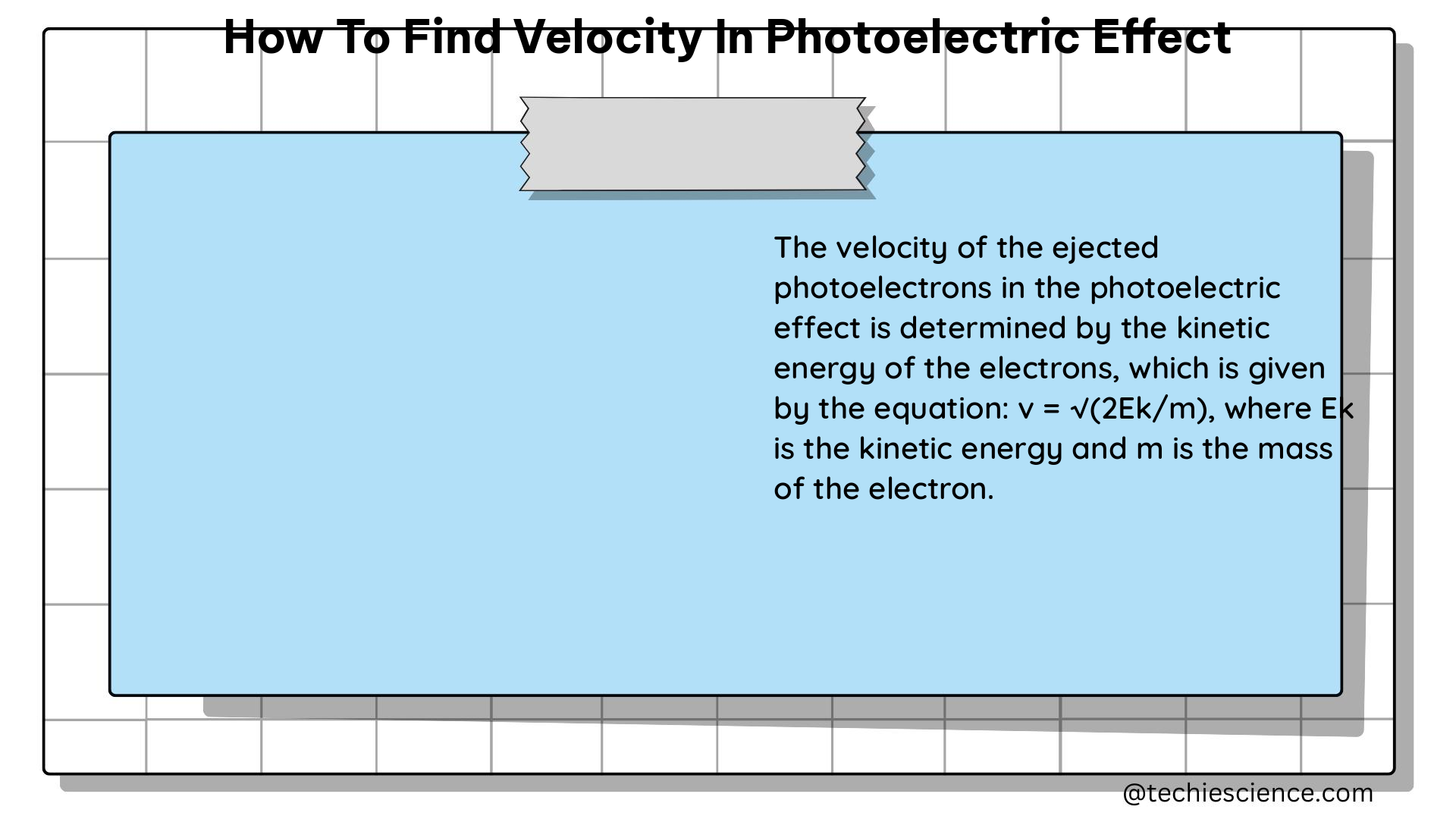The photoelectric effect is a fundamental phenomenon in quantum mechanics, where electrons are emitted from the surface of a material when it is exposed to light. Understanding the velocity of these emitted electrons is crucial in various applications, such as the development of photodetectors, solar cells, and electron microscopes. In this comprehensive guide, we will delve into the step-by-step process of determining the velocity of electrons in the photoelectric effect.
Calculating the Energy of the Incident Light
The first step in finding the velocity of emitted electrons is to calculate the energy of the incident light. This can be done using the equation:
E = hf or E = hc/λ
Where:
– E is the energy of the incident light (in Joules)
– h is Planck’s constant (6.626 × 10^-34 J⋅s)
– f is the frequency of the incident light (in Hz)
– c is the speed of light (3 × 10^8 m/s)
– λ is the wavelength of the incident light (in meters)
For example, if the frequency of the incident light is 2.1 × 10^15 Hz, the energy of the incident light can be calculated as:
E = hf
E = (6.626 × 10^-34 J⋅s) × (2.1 × 10^15 Hz)
E = 1.39 × 10^-18 J
Calculating the Kinetic Energy of Emitted Electrons

The next step is to calculate the kinetic energy of the emitted electrons. This can be done using the equation:
K = Ep – Φ
Where:
– K is the kinetic energy of the emitted electrons (in Joules)
– Ep is the energy of the incident light (in Joules)
– Φ is the work function of the material (in Joules)
The work function is the minimum energy required to remove an electron from the material. It is a characteristic property of the material and can be found in reference tables or measured experimentally.
For example, if the work function of the material is 4.7 eV (electron volts), the kinetic energy of the emitted electrons can be calculated as:
K = Ep – Φ
K = 1.39 × 10^-18 J – (4.7 eV × 1.602 × 10^-19 J/eV)
K = 4.72 × 10^-19 J
Converting Kinetic Energy to Electron Volts (eV)
Since the kinetic energy of the emitted electrons is often expressed in electron volts (eV), it is necessary to convert the value from Joules to eV. This can be done by multiplying the value in Joules by the conversion factor 1 eV = 1.602 × 10^-19 J.
For the example above:
K = 4.72 × 10^-19 J
K = (4.72 × 10^-19 J) / (1.602 × 10^-19 J/eV)
K = 2.94 eV
Calculating the Velocity of Emitted Electrons
Finally, the velocity of the emitted electrons can be calculated using the equation:
v = √(2K/m)
Where:
– v is the velocity of the emitted electrons (in m/s)
– K is the kinetic energy of the emitted electrons (in Joules)
– m is the mass of an electron (9.109 × 10^-31 kg)
Continuing the example:
v = √(2 × 4.72 × 10^-19 J / 9.109 × 10^-31 kg)
v = 1.19 × 10^6 m/s
Therefore, the average velocity of the emitted electrons in this example is 1.19 × 10^6 m/s.
Additional Considerations
- The photoelectric effect is influenced by various factors, such as the intensity and wavelength of the incident light, the material’s work function, and the surface properties of the material.
- The energy and velocity of the emitted electrons can be affected by the angle of incidence of the light, the presence of external electric or magnetic fields, and the temperature of the material.
- In some cases, the energy distribution of the emitted electrons may not be uniform, and the velocity of the electrons may vary depending on their energy.
- Advanced techniques, such as time-of-flight measurements or electron energy analyzers, can be used to study the detailed energy and velocity distributions of the emitted electrons.
Conclusion
In this comprehensive guide, we have explored the step-by-step process of determining the velocity of electrons emitted in the photoelectric effect. By understanding the equations and principles involved, you can now confidently calculate the velocity of emitted electrons in various photoelectric effect experiments. This knowledge is essential for understanding the fundamental behavior of electrons and their applications in various fields of physics and technology.
References
- Photoelectric effect (article) | Photons | Khan Academy
- Photoelectric effect – Wikipedia
- Photoelectric Effect – an overview | ScienceDirect Topics
- Finding the Average Velocity of Electrons Emitted in a Photoelectric Experiment with Given Incident Light Frequency and Material Work Function
- Photoelectric effect find velocity? – Physics Forums

The lambdageeks.com Core SME Team is a group of experienced subject matter experts from diverse scientific and technical fields including Physics, Chemistry, Technology,Electronics & Electrical Engineering, Automotive, Mechanical Engineering. Our team collaborates to create high-quality, well-researched articles on a wide range of science and technology topics for the lambdageeks.com website.
All Our Senior SME are having more than 7 Years of experience in the respective fields . They are either Working Industry Professionals or assocaited With different Universities. Refer Our Authors Page to get to know About our Core SMEs.